How frequently is your cat vomiting?
All cats vomit once in a while. Your cat vomiting once or twice a month is considered quite natural. However, that also depends on the type and content of the vomit.
Some cats throw up a hairball or two in 30 to 45 days. Some eat too fast and then throw up (regurgitate) the intact food. Sometimes, vomiting is a sign of a stomach disorder – indigestion, infection or something more serious.
Cats vomiting is a sign of discomfort and disorder, but it is not a diagnosis or disease. We need to understand the “what,” “how,” and “when” of cat vomit to understand the “why.”
Is your cat’s vomiting acute or chronic?
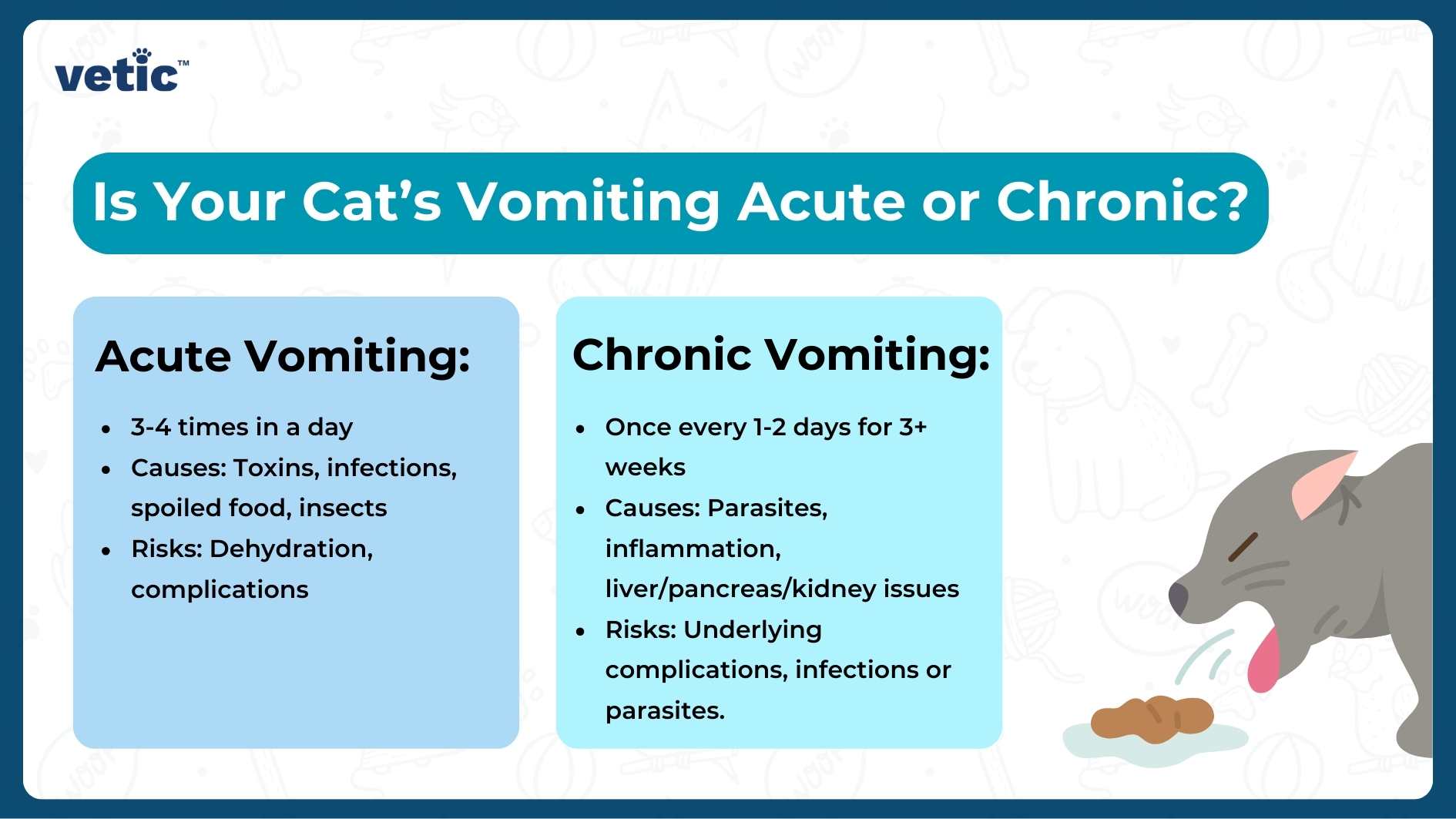
Is your cat vomiting 3-4 times today? Then it is considered an acute case. You should take your cat to the veterinarian before they become dehydrated and it becomes an emergency case.
Acute cases of cat vomiting can be caused by eating something toxic, a stomach infection, a viral infection or eating spoiled food or an insect. Acute vomiting is dangerous because it causes cats to throw up repeatedly and typically cats cannot keep any food down. It can lead to dehydration and further complications without veterinary intervention.
Chronic vomiting includes cases where the cat has been vomiting around once in one or two days for longer than 3 weeks. Chronic vomiting is often a sign of a persisting problem such as high stomach parasites, stomach inflammation, other infections or disorders of the liver, pancreas and/or kidneys.
What is the difference between a cat vomiting and regurgitation?
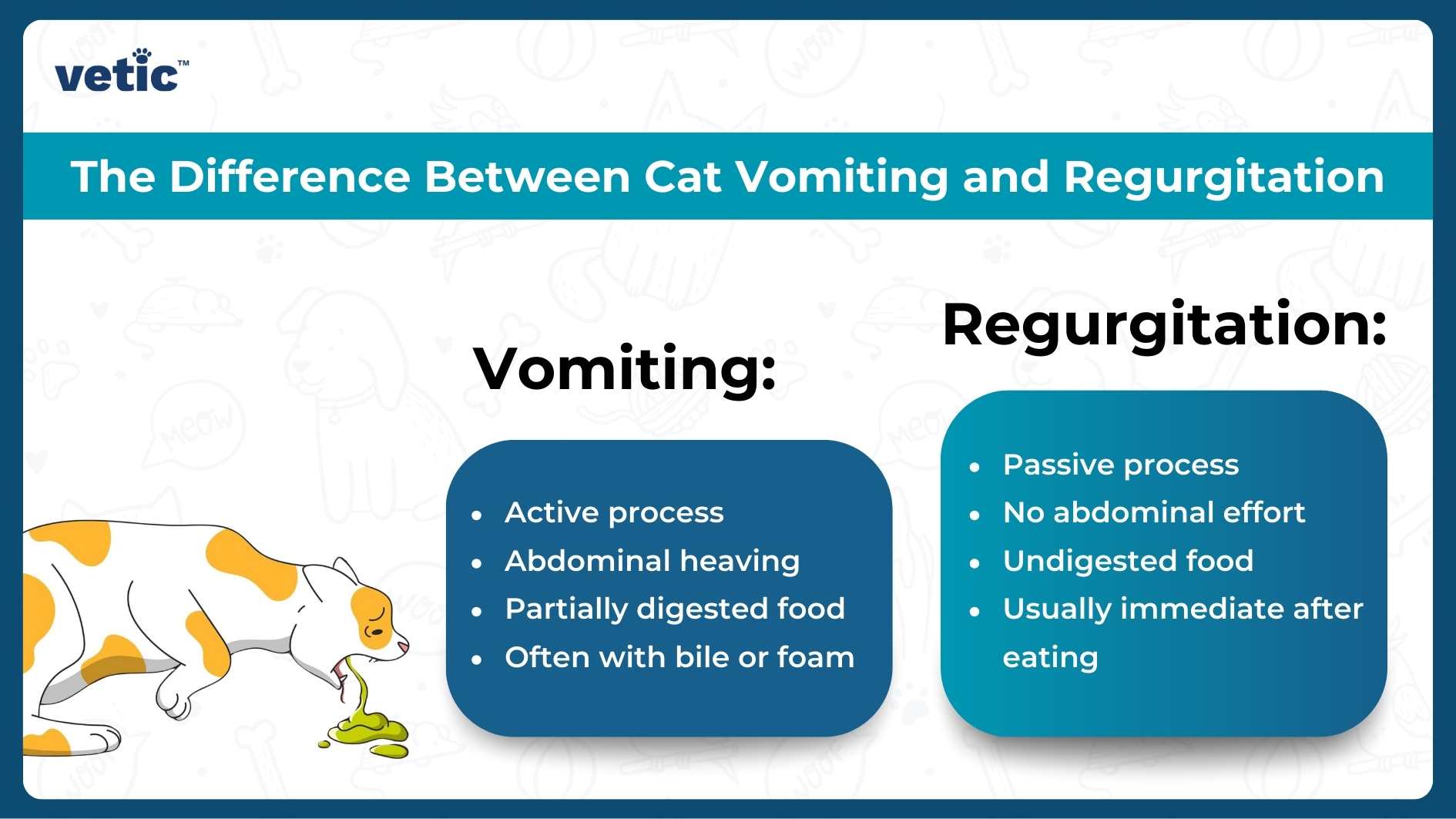
Now, sometimes, we confuse regurgitation with vomiting. Understanding the difference between them can bring you mental peace and help you seek veterinary care when it’s actually necessary.
Vomiting typically causes cats to feel restless and, even, anxious. Cats can show accompanying signs like forceful contraction of the abdomen, vocalisations, which finally leads to the expulsion of food or fluid. Vomiting, as you may have already experienced, involves significant effort.
Regurgitation is more of a passive process and involves the upper end of the food pipe. It is a quick and quite unpredictable process that occurs quickly without any abdominal contractions. Regurgitation in cats mostly occurs right after eating or drinking (and rapidly).
NOTE: You can always take a video when your cat begins vocalising or making the abdominal contractions before vomiting to show your vet. It can help them understand if your cat is actually vomiting, coughing or regurgitating.
What are some symptomatic treatments for acute vomiting?
Veterinarians often prescribe symptomatic treatment for cats vomiting acutely for less than 24 hours. It mostly consists of something to settle the stomach and an anti-emetic.
Experts also advise to feed your cat gastro-food that’s super easy to digest. Do not be surprised if your vet advises you to withhold food for a while to allow your cat’s stomach to settle.
However, since vomiting is a result of discomfort or disease and not the disease itself, it is never advisable to medicate your cat without speaking with a vet. You may be able to successfully suppress the vomiting for a day or two, but you cannot treat the underlying cause.
If your cat is vomiting more than 3-4 times within a short period of time, you absolutely must take them in for a veterinary examination that very day. The veterinarian will examine them for stomach pain, bloating and other possible causes of nausea before giving the right antiemetic (Yes! There are multiple types of anti-nausea and anti-vomiting medication for cats).
At the same time, the veterinarian will give a tentative observation period. If your cat doesn’t show any signs of improvement by then, your vet will change the medicines and prescribe tests to find out what’s causing your cat to vomit.
What colour is your cat’s vomit?
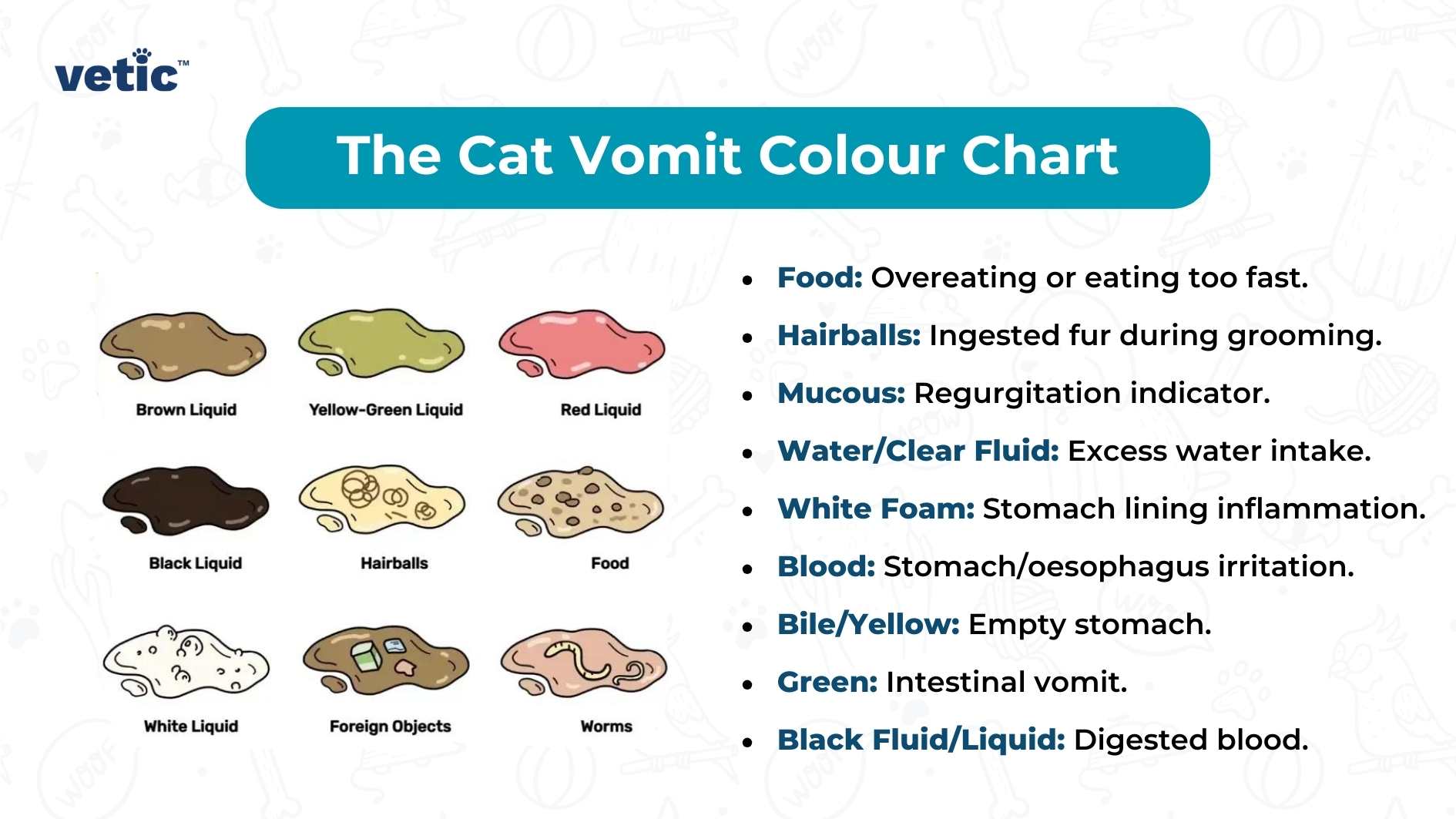
Knowing the colour and consistency of your cat’s vomit is very important to get your cat the right treatment. Here are some examples of the same and the potential possible cause(s) for each.
Food: Undigested or intact kibbles or food in your cat’s vomit typically means they ate too much, too fast. You can try slow feeders or give them small meals to avoid this problem in the future.
Hairballs: Cats will ingest some fur whenever they are grooming themselves. They form a ball-like structure in their stomach and it is expelled about once a month. You can avoid hairballs in cats if you brush them regularly and keep them well-groomed.
Mucous: Mucous is typically an accompaniment of regurgitation. If you notice mucous, try to understand if your cat is vomiting or regurgitating.
Water/Clear Fluid: When a cat throws up just clear fluid it is a sign that your cat has drunk too much water.
White Foam: White foam in cat vomit is a sign that the internal lining of your cat’s stomach is likely inflamed.
Blood: Fresh blood in your cat’s vomit may mean irritation of the stomach lining or oesophagus due to excess acidity. Or, your cat has hurt their oesophagus while throwing up repeatedly. It can also mean ulcers in the upper part of their stomach.
Bile/Yellow: Cats can vomit bile if they haven’t eaten anything in a long time. You need to consult a veterinarian to chalk out your cat’s diet and feeding frequency.
Green: Green vomit means your cat is throwing up food or other stuff from the small intestine (past the stomach). The mixture of bile and vomitus is usually green.
Black Fluid/Liquid: That is usually not good news since black liquid vomit contains digested blood. It results from injuries or ulcerations of the intestinal tract, ingestion of foreign bodies and even some infections.
Worms: As gross as it sounds, cats do vomit worms when they have not been dewormed timely or correctly. You need to consult the veterinarian for the correct deworming procedure of your cat, as well as any other pet you have in the house.
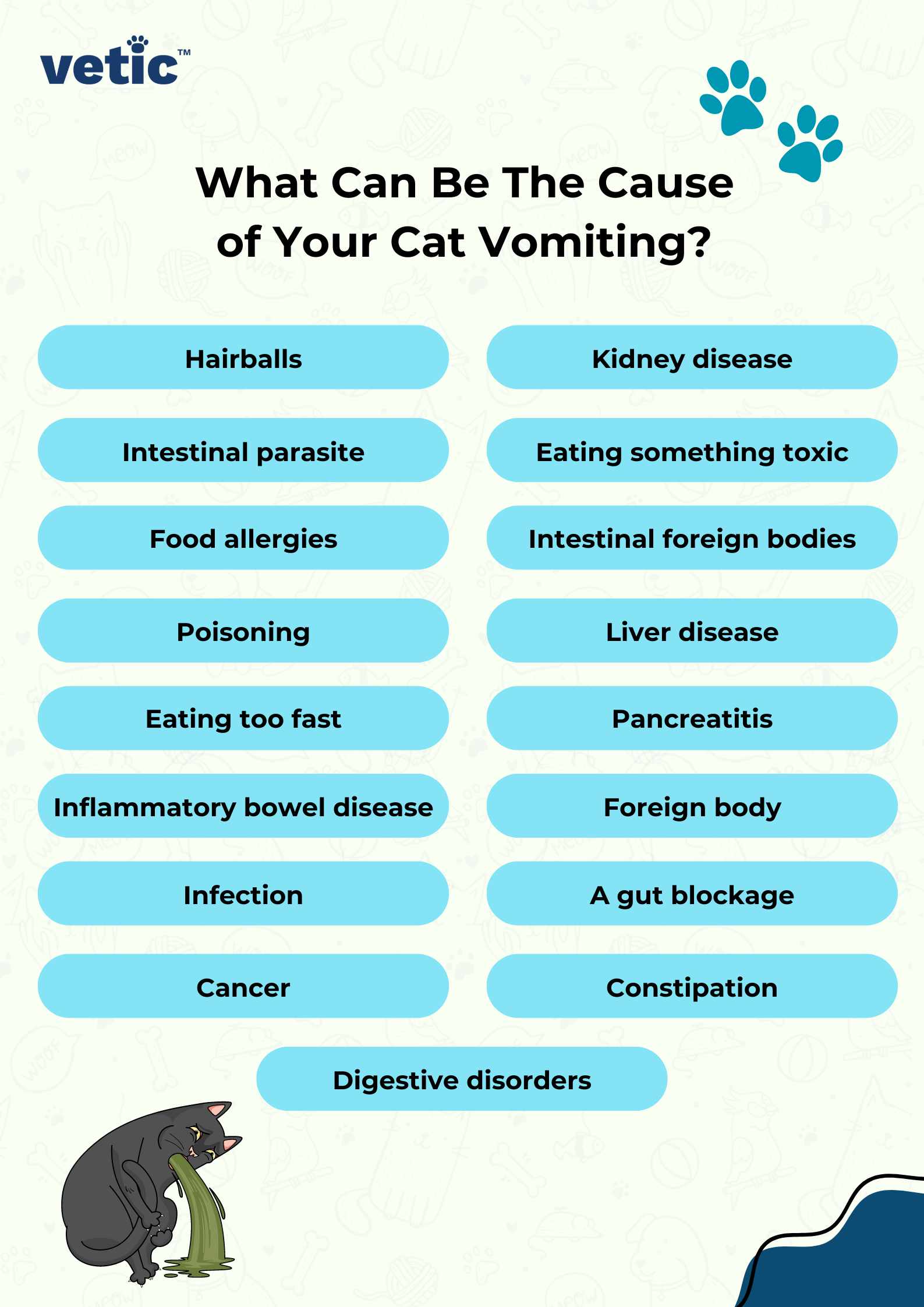
If your cat vomiting is normal, when should you be concerned?
There are certain situations when you need to worry about your cat vomiting. For example –
- When your cat is vomiting more than 3 to 4 times in a row.
- When your cat has diarrhoea and/or loss of appetite along with vomiting.
- Your cat has vomited and they have not had food or water for 12 hours.
- Your cat is showing signs of pain or distress, especially in the abdominal area.
- Your cat is vomiting but not passing stools for longer than 48 hours.
- There is a strange colour and/or smell to their vomit.
- Your cat may have eaten something toxic (plant or insect).
- You have recently started a medication or supplement.
- More than one of your cats is vomiting multiple times.
If your cat is showing additional signs of distress along with vomiting, it calls for a veterinary checkup. And remember to hurry because repeated vomiting can dehydrate your little friend quickly.
How do veterinarians determine if your cat vomiting is a sign of something serious?
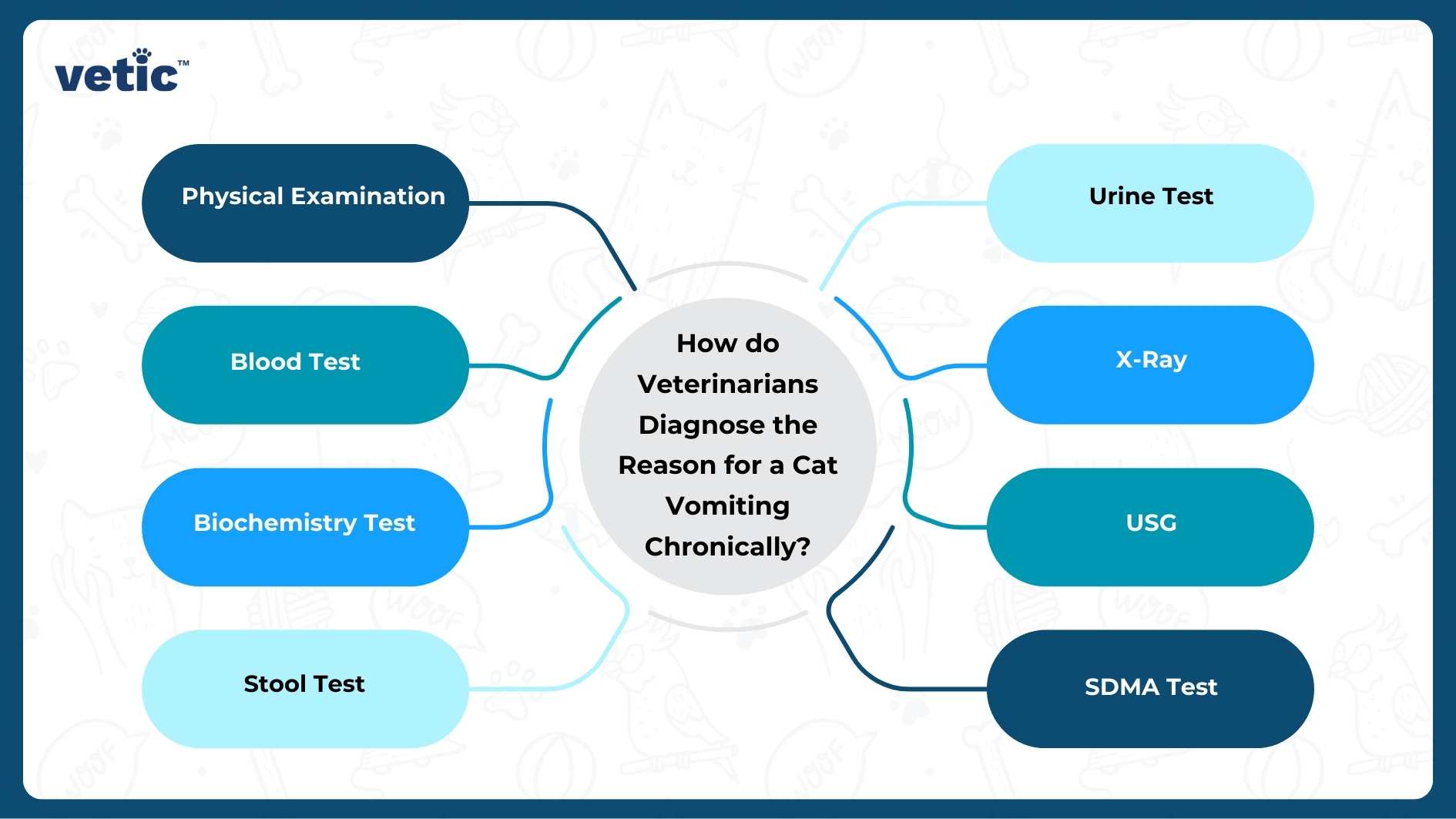
Once your veterinarian learns about the frequency, colour and consistency of your cat’s vomiting, they will decide whether symptomatic treatments will work, or your cat is showing signs of more severe disorders.
If your cat’s vomiting is chronic and not responding to antiemetic medication, then there is a chance that there are serious underlying problems causing your cat to throw up frequently.
What diagnostic testing is required to find the cause of your cat vomiting?
Repeated vomiting over a couple of weeks can signify serious issues such as stomach parasites (worms), blood parasites, liver problems, stomach infections, kidney diseases, pancreatitis or even a UTI.
These disorders and diseases cannot be treated with approximation, so your veterinarian will recommend blood tests, stool and urine tests, X-ray and/or USG depending on the other signs your cat is exhibiting, such as weight loss, appetite loss, and depression.
